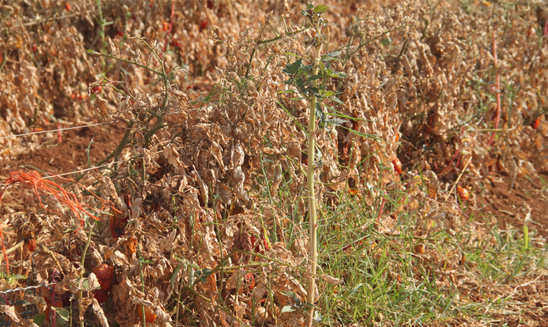
The Sunday Mail

Tafadzwa Kadani —
When Mr Gift Tshuma planted tomatoes on one-and-a-half hectares, he anticipated a good harvest of not less than 90 tonnes. With tomatoes fetching up to US$1 per kg, Mr Tshuma was counting his money. The first stages went by in blissful routine for the farmer from Kadoma. The crop developed as expected and it looked quite healthy.
But four weeks before harvest, disaster struck: a devastating pest — the tomato leaf miner — invaded Mr Tshuma’s field. Despite engaging agriculture experts to save the crop, the pest was resistant to chemicals and continued to affect the crop. Last week, Mr Tshuma and his workers were mournfully salvaging what is left of the crop in hope of getting a little money back.
The situation is not peculiar to Mr Tshuma alone as several tomato farmers in Kadoma and surrounding areas have been having tomato leaf miner-induced nightmares. The farmers want Government to quarantine the area. The leaf miner was first reported in Southern Africa early this year, and has invaded Mozambique, South Africa, Zambia and Zimbabwe.
Affected farmers say Zimbabwe needs to act with speed to deal with the looming disaster. Commonly known as the tomato leaf miner or South American tomato moth, the tuta absoluta is a species of moth in the Gelechiidae family. It is a notorious pest of tomato crops in Europe and South America, and now Southern Africa.
The larva feeds voraciously on tomato plants, producing large galleries in leaves, burrowing in stalks, and consuming apical buds and the tomato.
It is capable of causing a yield loss of 100 percent. Tuta absoluta thrives on the tomato plant, but can also attack other crops of the nightshade family, including potato, eggplant, pepper and tobacco.
According to one agronomist, the pest also feeds on chlorophyll taking away the life of a plant. Chemical control often fails due to the resistance of tuta absoluta to many pesticides, because a big part of its development takes place inside the plant or soil, out of reach of pesticides. The Sunday Mail Extra visited some of the farmers affected by pest and noticed common signs of the tuta absoluta invasion were visible.
 The pest has attacked crops at various levels of growth. One of the fields looked like it had been scorched: unhealthy tomatoes dangled from wilted stalks and mirrored the despondency of the farmers. Mr Paul Chikowe, who farms in Kadoma, said the tomato leaf miner had affected his entire crop.
The pest has attacked crops at various levels of growth. One of the fields looked like it had been scorched: unhealthy tomatoes dangled from wilted stalks and mirrored the despondency of the farmers. Mr Paul Chikowe, who farms in Kadoma, said the tomato leaf miner had affected his entire crop.
“The pest is very devastating and the most painful part is that it has destroyed our crop while we were watching helplessly because the chemical is not yet available in the country,” said Mr Chikowe.
“Considering the high volumes of tomato production in our country, especially after the Government banned imports, this pest must be taken seriously.”
Tomatoes are a quick source of income for both small-scale and commercial farmers, contributing immensely to job creation and economic wellbeing.
Should the pest thrive unchecked, tomato output will drastically fall and Zimbabwe will find itself importing this most basic of crops to meet local demand. It also means tomato prices will rise. A farmer accused Agriculture Research and Extension officers of “sleeping on the job”.
“We noticed this pest a month ago and we notified the Arex officers. A month is more than enough for them to do research and send an alert to other farmers,” said the farmer who refused to be identified for fear of reprisal.
“They are reluctant. We had to physically visit their offices and provide transport for the officers to attend to this problem.”
Kadoma-based agronomist Mr Tendai Njerere said the pest had dampened the hopes of farmers in the area.
“We were expecting between 90-120 tonnes of tomatoes per hectare but the pest has reduced our expected yield to almost nothing.
“In all my farming activities I have never seen such a destructive pest, it is twice as bad when compared to the army worm,” said Mr Njerere. Head of Plant Protection in the Ministry of Agriculture, Mechanisation and Irrigation Development Dr Godfrey Chikwenjere could not deny or confirm the outbreak. Said Dr Chikwenere: “I will be visiting the affected area to get samples so that we conduct a thorough investigation. We will definitely let the nation know if indeed the tuta absoluta has been detected in Zimbabwe.”
Tuta absoluta has a high rate of reproduction. It has a life cycle that starts as an egg, before developing into a caterpillar then caterpillar, chrysalis and adult. The female adult lays about 40 to 250 eggs, usually under the leaves or the shoot of a young and tender tomato plant. The eggs take up to six days to hatch, depending on temperatures
A male tuta absoluta can survive for up to six days while its female lifespan can get to 15 days, laying between 250-300 eggs. Signs of the pest invasion on tomatoes include irregular and discoloured leaves; dry leaflets larva nutrition activities on the stems, wilting of plant and rotting of fruit.



